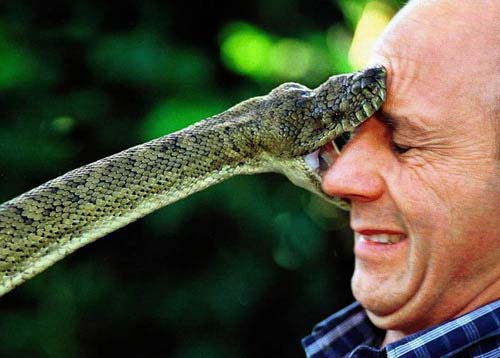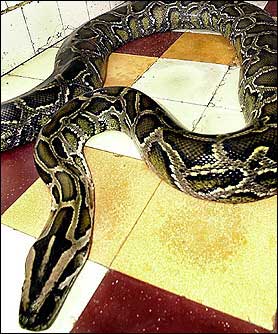Snake Charms
Snakes in ArtAlways carry a flagon of whiskey in case of snakebite and furthermore always carry a small snake. - WC Fields Snakes inspire an atavistic hatred. They are more loathed than bats, maggots or worms. Snakes slither. They are silent. They come and go without warning. They look slimy. Snakes have no differentiated body parts - no neck or limbs. Their eyes never close, and their expressions do not change. They are cold-blooded. They have a forked tongue. Baby snakes have no charm; they look like their parents, only smaller. Snakes are hard to anthropomorphize. They are mysterious, remote - the Other. Snakes crawl on the earth - a permanently debased condition. They are associated with the dank, mouldy floor of the forest. They lurk in tall grass and strike without warning; they drop from trees and squeeze their victims to death before swallowing them whole. More cults have been devoted to snakes than any other animal... To observers in the ancient world, snakes seemed to be immortal: resting in the shade, they appeared moribund, yet they revived miraculously in the warming sun; they shed their whole skin each year and emerged renewed. For many cultures - from the Indian subcontinent to the Mediterranean Basin - a coiled snake came to symbolise the navel of the universe; one swallowing its own tail represented the endless cycle of life and death. Throughout the world, snakes reminded people of the inevitability of death and the hope of rebirth.
"Danger on the Stairs" by artist Pierre Roy, 1927 or 1928
Snake trivia: Garter snakes do not lay eggs. Unlike most other snakes, they bear live young.
Monot Père et Fils et Stumpf, 1880. Crystal with copper particles, 2⅞" in diameter. Musée National des Techniques du CNAM, Paris Source: Snake Charm by Marilyn Nissenson and Susan Jonas 1995
Fear of SnakesForked tongues in snakes give them directional smell, the side with the stronger scent points to the source. by Matt Ridley [excerpt] Susan Mineka worked with a group of monkeys in Madison in the '80s, where she set out to examine the ontogeny of an instinct - in this case fear of snakes. Wild-born monkeys are afraid of snakes. They're so scared of snakes that they will cower in the back of the cage screaming rather than reach across a plastic model snake to get at a peanut when they're very hungry. Captive-born monkeys are not afraid of snakes; they happily reach across the model snake to get the peanut. This means that fear of snakes must be learned. But how on earth do monkeys learn fear of snakes? Either they've had a bad experience with a snake to learn from, in which case they're dead, or they haven't had a bad experience, in which case they haven't learned that snakes are frightening. Mineka argued that there is a program for fear of snakes, an instinct, that needs to be socially triggered - in some sense triggered by a vicarious experience, by observing other monkeys who fears snakes. She set up an experiment in which she videotaped a wild-born monkey reacting with fear to a snake and showed this video to a captive-born monkey, which immediately acquired a fear of snakes and was not then prepared to reach across even a model snake to get a peanut. Next, she doctored the video so that it had the same monkey reacting in the same way in the background, but the bottom half of the screen, instead of having a snake, now had a flower. Again, the captive-born monkey had never seen a flower, so after it saw a monkey reacting with extreme fear to a new thing called a flower it should just as easily learn a fear of flowers. But it didn't. It just learned that some monkeys are crazy. Clearly monkeys have an instinct for fear of snakes. That's not surprising - human beings have snake phobia, the most common of all the phobias, even though most hardly see a snake in their lives, but it requires input from the environment to be triggered. This happens in the amygdala... Matt Ridley is an Oxford-trained zoologist and science writer whose latest book is Nature via Nurture (HarperCollins) Source: edge.org from "The Genome Changes Everything"
More Reasons to Be Afraid of Snakes...
Source: thesun.co.uk sent to them by Si Cochrane
Source: thesun.co.uk sent to them by Harry Short
Big-Hearted Pythons Pull off Postprandial Trick
Paris - The Burmese python can increase the size of its heart chambers by 50% to help it digest a big meal. This is due to a protein which can expand its heart muscle. The snake's increase in heart size (over about 2 days) lets it cope with an incredible increase in metabolic rate during digestion - sometimes as much as 4,000%. A team led by U of California biologist James Hicks said the snake's secret is that it has genes that produce heavy-chain myosin proteins. When the heart muscle is flooded with these, the serpent's heart chambers quickly enlarge so that they can pump more blood to the digestive organs. The 3 groups of Burmese pythons that Hicks' team worked with fasted for 4 weeks. They were then allowed to eat rats up to 25% of their body weight. The food was then digested by the snakes for the next 4 weeks. (So why, I wonder, did their hearts need to expand all that fast? The rats would decay naturally in not too much longer than that.) Humans also have heavy-chain myosin but regular intense exercise is necessary before high enough levels of this protein are produced that heart function is improved. The study appeared in Nature, the British weekly science journal. Source: excerpted from story.news.yahoo.com Wednesday 2 March 2005 photo source AFP/File/Philippe Lopez
The previous page and the following two pages are also about snakes - the previous page is about Snakes in Life, the following page about Art nouveau Snakes, and the page after that about a possible Biological Anomaly? The "Back" and "Next" buttons below will also take you there. For another lovely example of snakes in art, see the short, graceful animation Snakes based on a woodcut by M C Escher - unfortunately the clip is 9meg and requires a Flash plugin (but worth it!). It will open in a new window...
For more on animals, including reptiles, crustaceans, arachnids, insects, fish, birds, pets, livestock, rodents, bears, primates, whales and Wellington's waterfront, click "Up" below to take you to the
Index for this Animals section. |
 Animals
Animals Animation
Animation Art of Playing Cards
Art of Playing Cards Drugs
Drugs Education
Education Environment
Environment Flying
Flying History
History Humour
Humour Immigration
Immigration Info/Tech
Info/Tech Intellectual/Entertaining
Intellectual/Entertaining Lifestyles
Lifestyles Men
Men Money/Politics/Law
Money/Politics/Law New Jersey
New Jersey Odds and Oddities
Odds and Oddities Older & Under
Older & Under Photography
Photography Prisons
Prisons Relationships
Relationships Science
Science Social/Cultural
Social/Cultural Terrorism
Terrorism Wellington
Wellington Working
Working Zero Return Investment
Zero Return Investment



